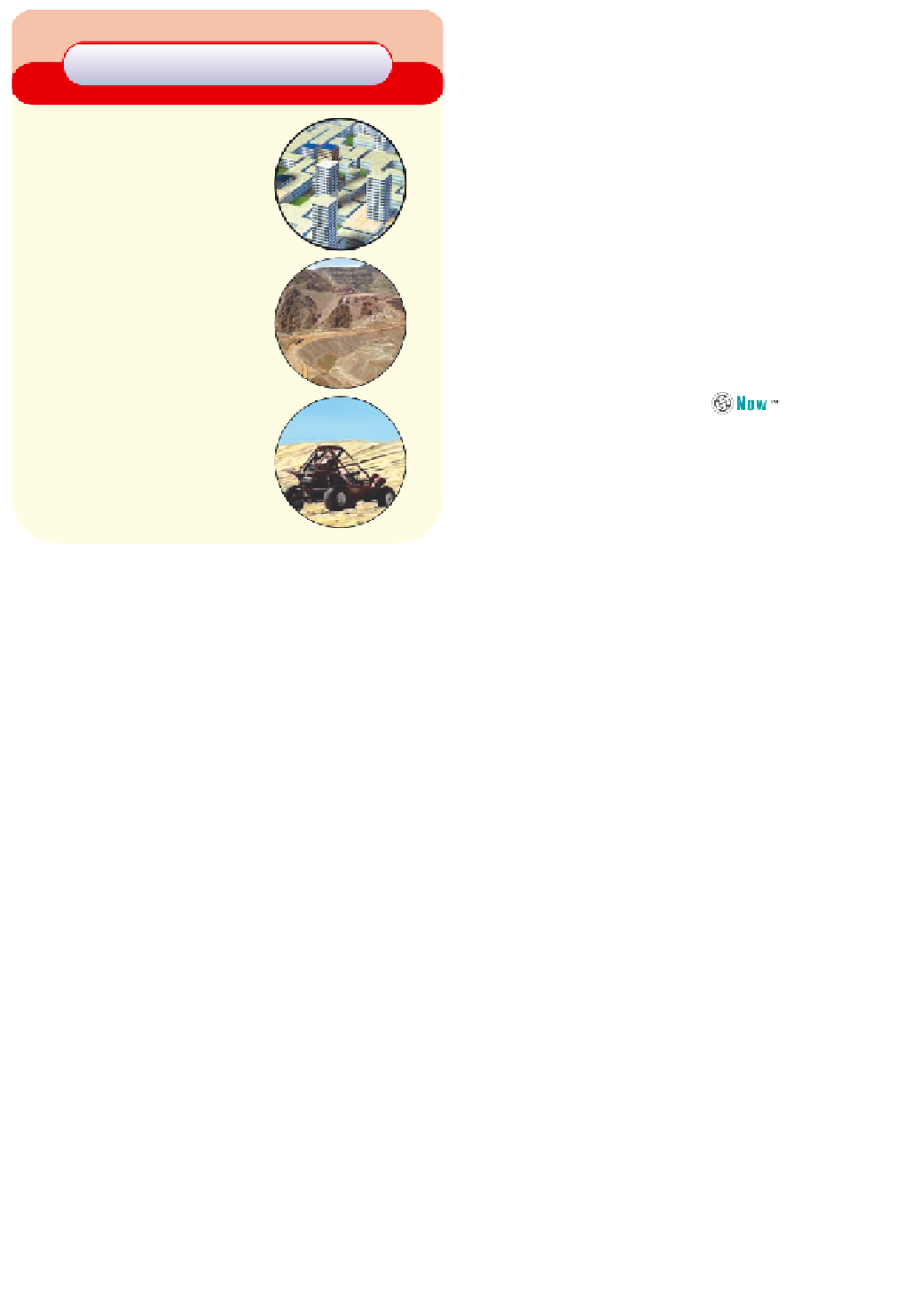Environmental Engineering Reference
In-Depth Information
work of intertwined roots of drought-tolerant grasses
unless the topsoil is plowed up and allowed to blow
away by prolonged exposure to high winds found in
these biomes.
Types of temperate grasslands include the
tall-grass
prairies
(Figure 5-12, p. 88) and
short-grass prairies
of the
midwestern and western United States and Canada.
Here winds blow almost continuously, and evaporation
is rapid, often leading to fires in the summer and fall.
Many of the world's natural temperate grasslands
have disappeared because they are great places to
grow crops (Figure 5-13, p. 88) and graze cattle. They
are often flat, are easy to plow, and have fertile, deep
soils. Plowing breaks up the soil and leaves it vulnera-
ble to erosion by wind and water, and overgrazing can
transform grasslands into semidesert or desert.
Natural Capital Degradation
Deserts
Large desert cities
Soil destruction by off-road
vehicles and urban
development
Soil salinization from irrigation
Depletion of underground
water supplies
Land disturbance and pollution
from mineral extraction
Storage of toxic and
radioactive wastes
Learn more about how plants and animals in a temperate
prairie are connected across a food web at Environmental
ScienceNow.
Large arrays of solar cells and
solar collectors used to
produce electricity
Polar grasslands,
or
arctic tundra,
occur just south
of the arctic polar ice cap (Figure 5-7). During most of
the year, these treeless plains are bitterly cold, swept
by frigid winds, and covered with ice and snow (Fig-
ure 5-14, left, p. 89). Winters are long and dark, and
the scant precipitation falls mostly as snow.
This biome is carpeted with a thick, spongy mat of
low-growing plants, primarily grasses, mosses, and
dwarf woody shrubs. Trees or tall plants cannot sur-
vive in the cold and windy tundra because they would
lose too much of their heat. Most of the annual growth
of the tundra's plants occurs during the 5- to 8-week
summer, when the sun shines almost around the clock
(Figure 5-14, right, p. 89).
One outcome of the extreme cold is the formation
of
permafrost,
soil in which the water it contains stays
frozen more than 2 years in a row. During the brief
summer the permafrost layer keeps melted snow and
ice from soaking into the ground. As a consequence,
the waterlogged tundra forms a large number of shal-
low lakes, marshes, bogs, ponds, and other seasonal
wetlands. Hordes of mosquitoes, black flies, and other
insects thrive in these shallow surface pools. They
serve as food for large colonies of migratory birds (es-
pecially waterfowl) that return from the south to nest
and breed in the bogs and ponds.
Another type of tundra, called
alpine tundra,
oc-
curs above the limit of tree growth but below the per-
manent snow line on high mountains (Figure 5-9, left).
The vegetation is similar to that found in arctic tundra
but receives more sunlight than arctic vegetation, and
alpine tundra has no permafrost layer.
Figure 5-15 (p. 89) lists the major human impacts
on grasslands.
Figure 5-11
Natural capital degradation:
major human
impacts on the world's deserts.
Critical thinking: what are the
direct and indirect effects of your lifestyle on deserts?
precipitation and various average temperatures (Fig-
ure 5-8).
One type of tropical grassland, called a
savanna,
usually has warm temperatures year-round, two pro-
longed dry seasons, and abundant rain during the
rest of the year. African tropical savannas boast enor-
mous herds of
grazing
(grass- and herb-eating) and
browsing
(twig- and leaf-nibbling) hoofed animals, in-
cluding wildebeests, gazelles, zebras, giraffes, and an-
telopes. These and other large herbivores have
evolved specialized eating habits that minimize com-
petition between species for the vegetation found on
the savanna. For example, giraffes eat leaves and
shoots from the tops of trees, elephants eat leaves and
branches farther down, Thomson's gazelles and
wildebeests prefer short grass, and zebras graze on
longer grass and stems.
In
temperate grasslands,
winters are bitterly cold,
summers are hot and dry, and annual precipitation is
fairly sparse and falls unevenly through the year.
Drought, occasional fires, and intense grazing inhibit
the growth of trees and bushes, except along rivers.
Because the aboveground parts of most of the
grasses die and decompose each year, organic matter
accumulates to produce a deep, fertile soil (Figure 3-22,
top right, p. 52). This soil is held in place by a thick net-







